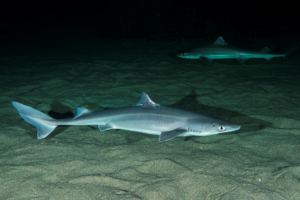Spiny dog fish
The spiny dogfish (Squalus acanthias) is an indigenous species along the entire Norwegian coast, including in Agder. This means that it “belongs here” and that it has a native distribution in Norway.
The spiny dogfish is a small, slim shark with a blunt snout. This shark can be around 1 m long. It has a black back and light underside and sports white dots along its back.
Sharks “breathe” by pumping water through their gills, thus feeding oxygen into the blood stream. A few shark species have lost the ability to actively pump water through the gills and will therefore asphyxiate if standing still. Spiny dogfish can be found in large schools, and usually at depths of 10 to 200 m.
The spiny dogfish eats everything from zooplankton, octopuses and crustaceans to pelagic, young fish as well as adult fishes like herring and cod.
The name “spiny dogfish” comes from the venomous spikes on its back. There are three venomous fish in Norway: spiny dogfish, rabbit fish (Chimaera monstrosa) and greater weever (Trachinus draco). The spiny dogfish’s venom is weak, and experts agree that it is the weever’s venom that is the worst. Still, it would be wise to seek medical help if stung by a spiny dogfish.

Spiny dogfish. Photo: Erling Svensen / Artsdatabanken
![]() The spiny dogfish was previously a commercial fish species, but a complete ban on fishing was introduced in 2011 due to a considerable population decline. In 2010 the species was classified as Critically Endangered (CR) on the Norwegian Red List, and Endangered (EN) in 2015. Today, the population has increased due to the strict measures implemented, but the spiny dogfish is still classified as a Vulnerable (VU) species.
The spiny dogfish was previously a commercial fish species, but a complete ban on fishing was introduced in 2011 due to a considerable population decline. In 2010 the species was classified as Critically Endangered (CR) on the Norwegian Red List, and Endangered (EN) in 2015. Today, the population has increased due to the strict measures implemented, but the spiny dogfish is still classified as a Vulnerable (VU) species.